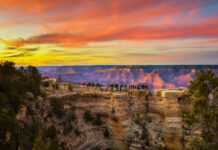 Sitting at his writing desk on a winter day, Herman Melville could look out the window and spy the hump of Mount Greylock, the highest peak in Massachusetts, rising above the snow-covered hills in the distance. When you visit Arrowhead, Melville’s onetime home outside the town of Pittsfield, you learn that Mount Greylock served as a stand-in for the famous white whale, and the rolling plains and hills that loomed between Melville’s desk and Greylock’s peak stood in for the endless sea. You learn that the greatest American seagoing novel was written not from a perch atop a rocky coast or in the suffocating hold of a whaling ship, but in a farmhouse way, way, inland.
Sitting at his writing desk on a winter day, Herman Melville could look out the window and spy the hump of Mount Greylock, the highest peak in Massachusetts, rising above the snow-covered hills in the distance. When you visit Arrowhead, Melville’s onetime home outside the town of Pittsfield, you learn that Mount Greylock served as a stand-in for the famous white whale, and the rolling plains and hills that loomed between Melville’s desk and Greylock’s peak stood in for the endless sea. You learn that the greatest American seagoing novel was written not from a perch atop a rocky coast or in the suffocating hold of a whaling ship, but in a farmhouse way, way, inland.
You also learn that it took Melville roughly a year to write “Moby-Dick”— significantly less time than it takes many of us to read the book.
Arrowhead, an easy 1 1/2-hour drive east from the Albany airport (itself an easy one-hour flight from Baltimore), was my first stop in the Berkshires, and it was the perfect launch for the weekend. After an informative tour of the house, I bought a T-shirt in the gift shop that reads, in the words of Melville’s immortal scrivener: “I would prefer not to.”
 Though Pittsfield calls itself the heart of the Berkshires, the wooded, hilly region of western Massachusetts famous for its natural beauty and cultural offerings, it’s hardly one of its most charming towns. So after leaving Arrowhead, I picked up Route 8, one of two main routes that span the Berkshires, and drove north along the Hoosac River to North Adams, home of the Massachusetts Museum of Contemporary Art (MASS MoCA) and my roost for the night, The Porches Inn.
Though Pittsfield calls itself the heart of the Berkshires, the wooded, hilly region of western Massachusetts famous for its natural beauty and cultural offerings, it’s hardly one of its most charming towns. So after leaving Arrowhead, I picked up Route 8, one of two main routes that span the Berkshires, and drove north along the Hoosac River to North Adams, home of the Massachusetts Museum of Contemporary Art (MASS MoCA) and my roost for the night, The Porches Inn.
A truly inspired example of imaginative reuse, Porches is the brainchild of Nancy Fitzpatrick, whose family owns the fabled Red Lion Inn in the southern Berkshires town of Stockbridge. It was Fitzpatrick’s idea to convert six dilapidated 1890s Victorian rowhouses into a luxury inn that would house visitors flocking to MASS MoCA, which occupies a vast former textile mill across the street.
During the renovation, the exteriors were left intact, though each was painted a different vibrant color: salmon, sage green, deep red, blue and so on. So when you arrive at Porches you really do feel like you’re entering a mill village (albeit one sans belching smokestacks, union troubles, child labor, etc.). You leave your car in the parking lot at the edge of the complex and step onto one of the long porches that connect the six houses.
 Inside the marigold house is the reception desk, as well as two public lounging areas— one with a cozy fireplace— and a sunny breakfast room. The collection of 1950s TV lamps on display is an apt introduction to the whimsy and cleverness that characterize every element of Porches’ interior design. The spaces that once separated the houses, for example, have been enclosed and topped with skylights to create light wells. Vintage Mohawk Trail china plates hang on the walls; paint-by-number paintings conceal wall safes; and 1940s lamps sit atop painted nightstands.
Inside the marigold house is the reception desk, as well as two public lounging areas— one with a cozy fireplace— and a sunny breakfast room. The collection of 1950s TV lamps on display is an apt introduction to the whimsy and cleverness that characterize every element of Porches’ interior design. The spaces that once separated the houses, for example, have been enclosed and topped with skylights to create light wells. Vintage Mohawk Trail china plates hang on the walls; paint-by-number paintings conceal wall safes; and 1940s lamps sit atop painted nightstands.
Everywhere I looked, I saw evidence of care and thought— not to mention reverence for the buildings’ original identity as millworkers’ homes— from the painted wooden floors to the beadboard paneled walls to the linen curtains that hang on a wire (perhaps the way the millworkers might have done, though in the interest of thrift, not fashion).
My delight at the ingenuity was, however, tempered by the discovery of a price list in my room that informed me that, for $350, I could buy myself a rocker just like the one I was sitting in. And, for $900, I could take home the rug. In case I was crazy for the makeup mirror, I could get it for $55. Certainly I understand that hotels and inns want to offer guests the opportunity to purchase items they see in their rooms— not to mention increase their revenues and extend their brand. But it’s a real annoyance (not to mention, tacky) to find a price list when you’re looking for tips on restaurants and sightseeing. I wasn’t the only one grumbling about the price list; I heard a few other guests gossiping about it, too.
 I almost forgave the “hotel room hostage marketing” (my term— you heard it here first) the next morning when my breakfast was delivered to me in an aluminum lunch pail a la “olde tyme” millworkers. Thankfully, it contained not a soggy sandwich or can of sardines, but a thermos of delicious coffee, a flaky croissant and a ripe pear. Thus fortified, I strolled across the street to MASS MoCA.
I almost forgave the “hotel room hostage marketing” (my term— you heard it here first) the next morning when my breakfast was delivered to me in an aluminum lunch pail a la “olde tyme” millworkers. Thankfully, it contained not a soggy sandwich or can of sardines, but a thermos of delicious coffee, a flaky croissant and a ripe pear. Thus fortified, I strolled across the street to MASS MoCA.
Since its opening in 1999, MASS MoCA has served not only as the nation’s largest and most exciting incubator for contemporary visual and performing art, but also as a successful example of “cultural community development” that’s being studied by down-on-their-luck towns every- where. Before MASS MoCA, North Adams was a struggling, played-out mill town with a 13-acre, abandoned industrial site hulking at its margin. Though it would be an overstatement to say that MASS MoCA has “saved” North Adams overnight, six years later, the town is home to several new fine-dining restaurants and The Porches Inn, evidence that culture-vulture tourists are injecting life into the local economy.
When it comes to contemporary art, I am often with Bartleby; I would prefer not to. But I was intrigued and moved by the paintings and installations on display at MASS MoCA, particularly in the football-field-sized gallery, where Ann Hamilton’s piece “Corpus” took my breath away. Maybe it’s because the site is connected to work and thus is down to earth, or maybe it’s just the vibe, but MASS MoCA is a place where both the hippest New Yorker and the local-est yokel can feel comfortable.
 Though I’m not normally one for visiting two art museums in a single day, I decided to make an exception for the Sterling and Francine Clark Art Institute, located in what may be the quaintest college town on Earth, Williamstown, Mass., home of Williams College, just 10 minutes west of North Adams. Opened in 1955 by Singer sewing machine heir Robert Sterling Clark and his French-born wife, the Clark institute is famous for its collection of French Impressionists. It’s a small and beautiful museum full of luminous portraits and pretty landscapes, the perfect counterpoint to MASS MoCA.
Though I’m not normally one for visiting two art museums in a single day, I decided to make an exception for the Sterling and Francine Clark Art Institute, located in what may be the quaintest college town on Earth, Williamstown, Mass., home of Williams College, just 10 minutes west of North Adams. Opened in 1955 by Singer sewing machine heir Robert Sterling Clark and his French-born wife, the Clark institute is famous for its collection of French Impressionists. It’s a small and beautiful museum full of luminous portraits and pretty landscapes, the perfect counterpoint to MASS MoCA.
In between the two museums, I took a quick detour on Route 2, aka The Mohawk Trail, the scenic auto route from Boston to the Berkshires that was heavily promoted in the 1950s. A few miles east of North Adams, I pulled off at the Hairpin Turn, taking special care not to cause a domino-effect on the long row of parked Harley-Davidsons, and marveled at the spectacular Hoosac Valley. Though the leaves were just beginning to turn, the view was stunning.
As great as my visit to the Berkshires had been so far, it had all been a prelude, as I discovered when I headed south from Williamstown and took the gravel road that leads to the Guest House at Field Farm. Picture a five-room inn set on 316 acres of preserved forest, fields and wetlands. Then consider that this five-room inn is actually a single-family home built by architect Edward Goodell in 1948 and furnished with original pieces from Modernism’s heavy hitters: Eames, Nelson, Noguchi, Kagan, Knoll. Since it’s an inn— not a museum— you can sit on the Eames chair and set your coffee (with a coaster) on the Noguchi table. You can marvel at the cutting-edge design features of the day— curved walls, cork floors, built-in shelves, hand-painted fireplace tiles, Art Moderne lighting fixtures— as well as sculptures and paintings on loan from the Whitney Museum in New York, and pretend you live there.
After innkeeper Bob Chok showed me my room, complete with a balcony offering a view of Mount Greylock that Melville would have envied, he told me a bit about Lawrence Bloedel, the wealthy art and nature lover who, with his wife, bought the land and built the house as a home for his expanding collection of American art. Bloedel died in 1976, leaving his land to the Trustees of Reservations, a century-old preservation group in Massachusetts. But he didn’t make any provisions for the house, which soon was slated for demolition. Luckily, someone thought of an imaginative reuse along the same lines as The Porches Inn: convert the house into a bed and breakfast.
 I explored the Bloedels’ sculpture garden and strolled on one of the four hiking trails that meander through the property before Chok gave me a tour of the Folly, the guest house renowned architect Ulrich Franzen designed for the Bloedels in 1966. As much as the main house offers a snapshot of cutting-edge mid-century design, the Folly, with its perfectly preserved Franzen-designed kitchen and cabinets by St. Charles, offers a snapshot of the cutting-edge 1960s.
I explored the Bloedels’ sculpture garden and strolled on one of the four hiking trails that meander through the property before Chok gave me a tour of the Folly, the guest house renowned architect Ulrich Franzen designed for the Bloedels in 1966. As much as the main house offers a snapshot of cutting-edge mid-century design, the Folly, with its perfectly preserved Franzen-designed kitchen and cabinets by St. Charles, offers a snapshot of the cutting-edge 1960s.
The next morning, after a delicious breakfast served on vintage china at a dining room table designed by Skovby of Denmark to match the home’s original dining table (which was designed by Vladimir Kagan), I took my leave of the Guest House at Field Farm, feeling at once like telling everyone and no one about it.
In the afternoon I drove to Lenox, a short distance south, to The Mount, Edith Wharton’s home, which is open for tours even though it’s undergoing a major, room-by-room renovation. Of course I knew Wharton was a major American writer, but I didn’t know she was also a pioneer of American interior design, having co-authored the groundbreaking 1897 book “The Decoration of Houses,” which is still in print. When Wharton designed The Mount, she enacted the philosophy she’d advocated in her book, largely that “interior decoration should be simple and architectural,” its beauty a result of balance, symmetry and classical proportions— not the Victorian clutter in vogue at the time.
After The Mount was completed in 1902, Edith Wharton awoke early each morning and wrote in bed, surrounded by a passel of tiny dogs, tossing the pages on the floor when she was finished with them.
In the decade she lived in the Berkshires, Wharton wrote six novels, three nonfiction books and several short stories. Her productivity— and eventual fame— nearly equals that of her fellow writer who, a half-century before, had chased a white whale through the hills nearby.
Details
Southwest Airlines offers round trips from Baltimore to Albany, N.Y., starting from roughly $100. From there, it’s an easy drive on Route 20 east to Pittsfield, the heart of the Berkshires. From Pittsfield, take Route 8 north to North Adams, or Route 7 south toward Stockbridge. Leaf-peeping can be done throughout October along these routes, or along more crowded Route 2. Contact the Berkshires Visitors Bureau at 800-237-5747 (http://www.berkshires.org).
Stay
The Porches Inn in North Adams (http://www.porches.com; 413-664-0400) is within walking distance of MASS MoCA and several restaurants, and in easy driving distance of all the sights in the northern Berkshires. A bit more remote, but definitely worth the drive, is the unforgettable Guest House at Field Farm, south of Williamstown (http://www.guesthouseatfieldfarm.org; 413-458-3135). Even if you don’t stay overnight, you can walk the five miles of trails and enjoy the views of Mount Greylock. For a home base at the southern end of the Berkshires, consider The Red Lion Inn in Stockbridge, an 18th-century inn immortalized in Norman Rockwell’s painting “Main Street, Stockbridge” (http://www.redlioninn.com; 413-298-5545).
Play
A cultural tour of the Berkshires, from north to south, could include the Sterling and Francine Clark Art Institute in Williamstown (http://www.clarkart.edu; 413-458-2303); MASS MoCA in North Adams (http://www.massmoca.org; 413-662-2111); Arrowhead in Pittsfield (http://www.mobydick.org; 413-442-1793); The Mount Estate and Gardens in Lenox (http://www.EdithWharton.org; 888-637-1902); and The Norman Rockwell Museum at Stockbridge (http://www.nrm.org; 413-298-4100). Even after the performance season ends in September, it’s worth visiting Tanglewood in Lenox to stroll the grounds and marvel at the Koussevitzky Music Shed and Seiji Ozawa Hall (http://www.bso.org; 413-637-5135). For a bit of nature with your culture, drive or hike to the summit of Mount Greylock, where you can look out over five states (the auto road is generally open mid-May to Nov. 1; call 413-499-4262 to check).




